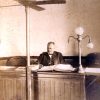calsfoundation@cals.org
Military Board (Civil War)
The Military Board was a three-man committee formed by the Secession Convention to raise troops in Arkansas after President Abraham Lincoln called for volunteers to fight for the United States following the Confederate attack on Fort Sumter in South Carolina. It served with varying measures of success throughout the Civil War.
The Secession Convention passed an ordinance creating the Military Board on May 15, 1861, giving it the authority to call out volunteer troops and militia companies to defend Arkansas and to control forts and armaments in the state, though acting as an auxiliary to the Confederate government. The board would consist of Governor Henry Rector and two advisory members. The first advisory member, appointed on May 16, was Benjamin C. Totten, a convention delegate from Prairie County; the second was Arkansas Gazette editor Christopher C. Danley. The board formally organized on May 23, with Rector serving as president and D. David Walker of Des Arc (Prairie County) serving as secretary. The convention set aside $2 million for the board to use for military purposes.
Three days before the Military Board organized, the Secession Convention formed an Army of Arkansas, and even though it was to be under the orders of the board, the convention delegates named James Yell as commander of the army and Thomas H. Bradley and N. Bart Pearce to lead its two divisions, centered at Pocahontas (Randolph County) and in northwestern Arkansas, respectively. The board contacted Confederate president Jefferson Davis and asked him to send generals to Arkansas to take the volunteer troops into Confederate service, after which the board’s responsibility would come to an end and the Confederacy would be responsible for defending the state.
Danley resigned his position on the Military Board on June 5 but was dispatched to Richmond, Virginia, to formally offer all of Arkansas’s troops and weapons to the Confederacy; he was replaced by Samuel L. Williams of Little Rock (Pulaski County). Danley claimed his resignation was due to private affairs, but he had been consistently outvoted by Rector and Totten, who were increasingly opposed to releasing the troops from state control. When Brigadier General William J. Hardee arrived as the Confederacy’s lead man in Arkansas, the board made an agreement with him that the state troops would have to consent to the transfer to Confederate service, and if a majority of a company did not then the unit would disband. Yell, in charge in Pocahontas after Bradley’s dismissal, argued against the transfers, and ultimately only 805 men there joined the Confederate service.
Pearce in northwestern Arkansas was also against the transfer of his men to the Confederacy. He first refused to have them sworn into state service, and following the victory at Wilson’s Creek in Missouri, argued so strongly against Confederate service that almost all of his state troops chose to go home, leaving only a handful of men to join the Confederate army. The Military Board, Rector, Hardee, and Brigadier General Ben McCulloch (commanding troops in northwestern Arkansas) all issued calls for additional volunteers for varying lengths of service, but with little success.
The Military Board’s membership changed in late 1861, with Williams leaving to serve in the Confederate army and be replaced by L. D. Hill of Perry County. Totten resigned, and Jacksonport (Jackson County) businessman Charles W. Board took his position. Rector would be replaced by Harris Flanagin after losing the 1862 gubernatorial election. The Arkansas House of Representatives passed a bill in November 1861 that would have abolished the Military Board and placed its powers in the governor’s hands, but it did not pass the Senate, and the board continued to exist throughout the war.
After Major General Earl Van Dorn arrived in Arkansas in January 1862, the Military Board issued a call for one hundred twelve-month infantry companies and four artillery batteries. They divided the state into four districts with a troop quota for each and the threat of conscription if there were insufficient volunteers. The troops who were raised through this call were transferred east of the Mississippi River after Van Dorn’s loss in the Battle of Pea Ridge, leading Rector to threaten to secede from the Confederacy and to issue a call for 4,500 volunteers in May 1862. The Military Board transferred all of those men to Confederate service when Major General Thomas C. Hindman took command of the Trans-Mississippi District at the end of the month. The board continued its efforts to raise and equip troops for both state and Confederate service until its activities, for all intents and purposes, stopped after the Camden Expedition in the spring of 1864. It spent a total of $1,691,699 of its original appropriation in fulfilling its duties.
For additional information:
Dougan, Michael B. Confederate Arkansas: The People and Policies of a Frontier State in Wartime. Tuscaloosa: University of Alabama Press, 1976.
Huff, Leo E. “The Military Board in Confederate Arkansas.” Arkansas Historical Quarterly 21 (Spring 1967): 75–95.
Mark K. Christ
Little Rock, Arkansas
 Civil War through Reconstruction, 1861 through 1874
Civil War through Reconstruction, 1861 through 1874 Law
Law Military
Military ACWSC Logo
ACWSC Logo 



Comments
No comments on this entry yet.